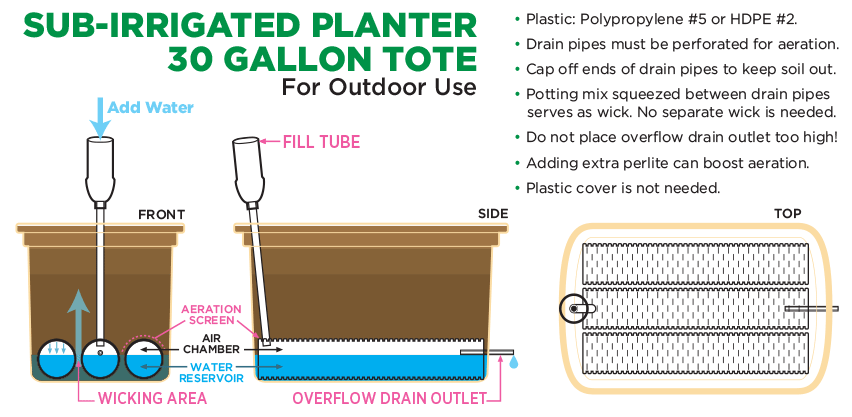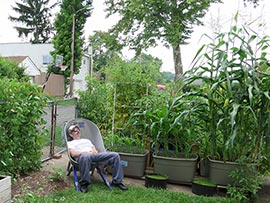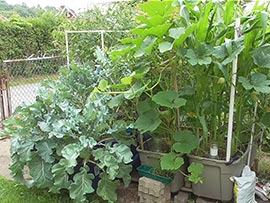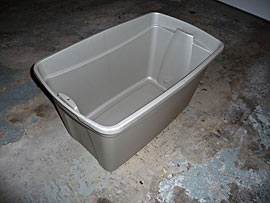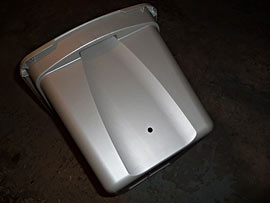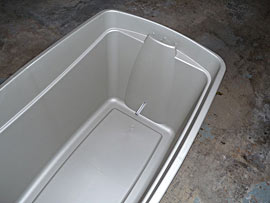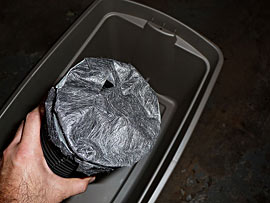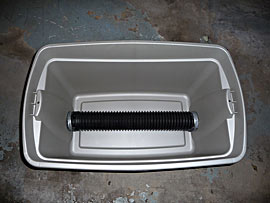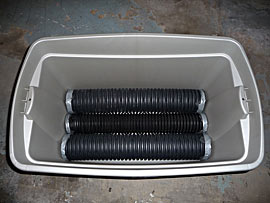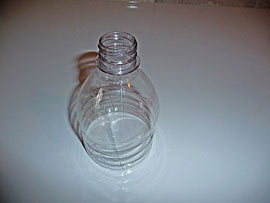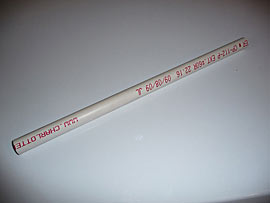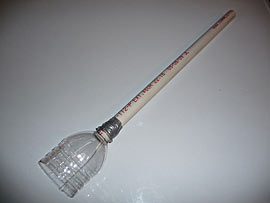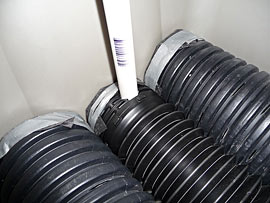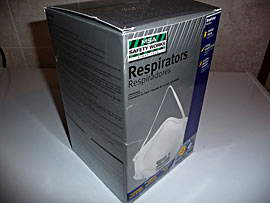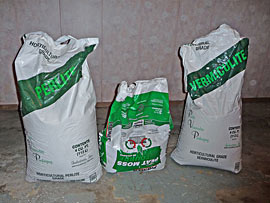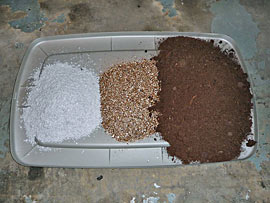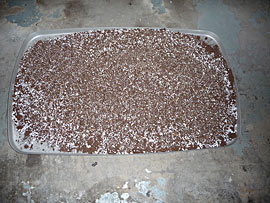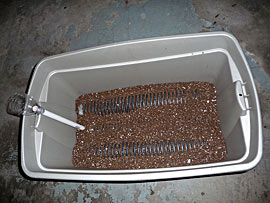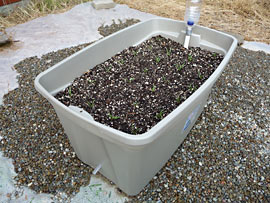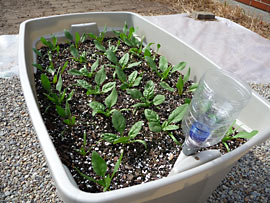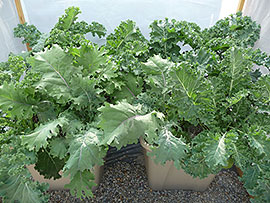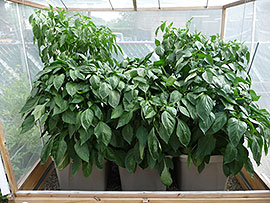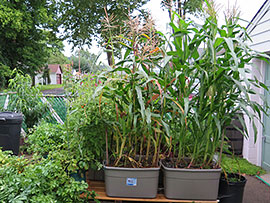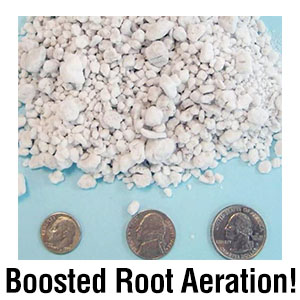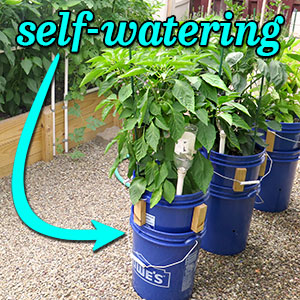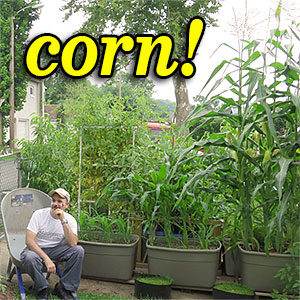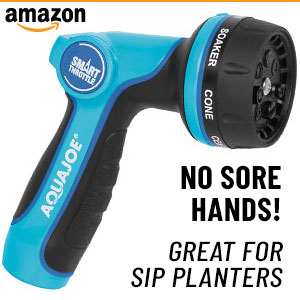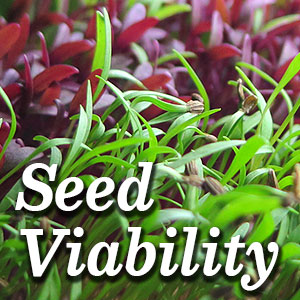30 Gallon SIP Wicking Tote:
Creating a Sub-irrigated
Tote Garden Planter
The AlboPepper self-watering 30 gallon tote SIP is an excellent way to use sub-irrigated planters in your urban garden. I'm sharing this design which I adapted to suit my needs. I would say that 90% of the idea has been out there on the internet for years. This is a refined method that I've tested and had great success with. It's easier and faster to construct than other techniques which is a real plus!
This cheap DIY wicking planter actually works better than many retail self-watering kits (such as EarthBoxes or City Pickers) because of it's increased soil capacity and water reservoir size. It has a very stable base and can support large vegetable plants. Perfect for patios, decks or for tenants who want to be able to take their garden with them.
CAPACITY:
Estimated: 25 gallons of potting mix.
Reservoir: 3 gallons of water.
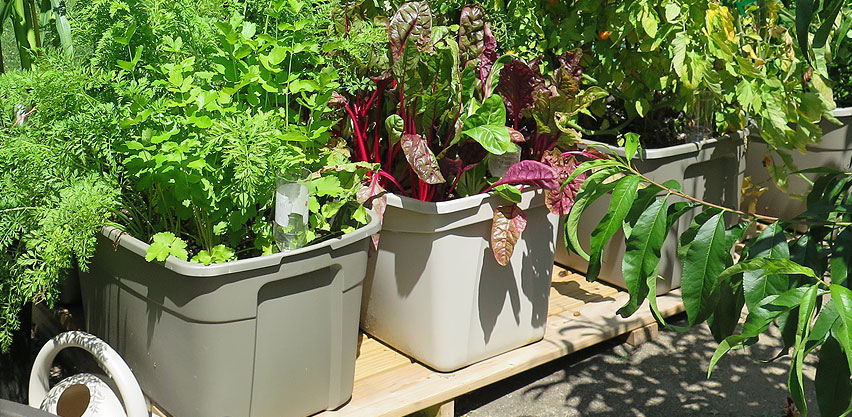
These 30 gallon SIP tote planters are an easy portable way to garden without needing native soil.
I've grown large pepper plants, lush kale, full sized corn stalks and massive tomato plants in these tote systems. My spinach crop was explosive. I've even grown squash, broccoli and watermelons. Just about any annual vegetable will grow well. For extra large vegetables, some crops should be limited to one plant per tote. Otherwise, these are great for beginner gardeners who are trying out different plant locations and spacing arrangements.
How Does a Self-watering Tote Work?
THE SELF-WATERING TOTE ADVANTAGE: Growing your annual garden vegetables in SIP totes is a much more resilient form of container gardening. Drought management is easier on two fronts: 1) Reduced water runoff. 2) Easier manual watering.
REDUCED WATER RUNOFF: Watering your totes a little every day allows you to keep track of your vegetable health. At the same time you don't actually HAVE to fill the water reservoir until it overflows. Watering in this fashion means ZERO runoff. And when it rains, much of that natural precipitation will be trapped in the partially filled reservoir before finally reaching the point of overflow. Self-watering containers are much less wasteful than conventional drain-hole pots.
Video: Self-watering Planter Basics:
DIY Gardening with Sub-irrigated Wicking Beds
This video is a perfect intro to the basics of how a self-watering SIP works. 
EASIER MANUAL WATERING: First of all, depending on the weather and plant size, I've been able to go for weeks without watering what-so-ever. But in the Summer or during a drought, when you must water, the process is much easier. Using a fill tube makes it effortless. I recommend a garden hose nozzle that does not require you to constantly squeeze the trigger. This allows you to place the nozzle on a low to medium setting as you devote your attention to the plants themselves.
As an added option, you could even create an external sub-box containing a float valve. This would allow you to truly automate the process. Just be careful you don't rack up too much time in the hammock! Your plants still need attention now and again. ;-) Trust me, these plants can get BIG!!!
Directions: How to Build a Wicking Tote
MATERIALS LIST:
- 30 Gallon Plastic Storage Container
- 4" Perforated, Corrugated Drain Pipe
- 1/2" Rubber Tube (6" length)
- Landscaping Fabric (for capping off ends of drain pipe)
- 1/2" Outside Diameter PVC Pipe (for vertical downspout)
- Empty Water Bottle
- Duct Tape
- My personal (1st) recipe for mix*:
- Use a Respirator Mask!
- Peat Moss
- Vermiculite
- Perlite
- Miracle Grow Potting Mix
- 1/3 cup Dolomitic Lime
- 1 cup All-Purpose Fertilizer
* Note: 2/3 of my mix was Miracle Grow, which is already pH balanced and fertilized.
As a result, I didn't add as much Lime or Fertilizer.
CONTAINER:
- Drill a hole to snugly fit your Rubber Tube & slide the tube halfway in.
- Cut your Drain Pipe sections to stretch lengthways into the bottom of container.
- Cap them off with fabric, to keep out dirt.
- Drill a hole into the top of the center Drain Pipe to fit the PVC Pipe.
- Cut a hole into the opposite end of the Drain Pipe for the Rubber Tube.
- Place the center Drain Pipe & the other 2 Drain Pipes into container.*
- Cut the Water Bottle in half & tape the lip of Bottle to the end of PVC Pipe.
- Place the other end of PVC Pipe into Drain Pipe.
* Note: In this particular container, I used a smaller drain pipe in the center.
It is a 4" inch flexible, expandable pipe.
This allowed everything to fit nicely.
SIP POTTING MIX:
- Put on your Respirator Mask.
- Mix bottom layer of soil: 1 gallon Vermiculite + 1 gallon Perlite + 3 gallons Peat Moss.*
- Make sure it is lightly moistened & gently pack it under & around the Drain Pipes.
- Mix 2 cu ft bag MG Potting Mix with 2 gallons Vermiculite + 2 gallons Perlite + 4 gallons Peat Moss.
- Add 1 cup All-Purpose Fertilizer + 1/3 cup Dolomitic Lime & mix all together.
- Add Potting Mix & place container on a level spot where it will get plenty of sunlight.
- Fill with water, using downspout, until Rubber Tube starts to overflow.
Note: I use extra Perlite & Vermiculite in the bottom layer. These are inorganic and won't decay, maintaining good wicking.
Step-by-Step Photo Instructions:
← READ MORE: How to Fertilize SIPs
READ MORE: HOW TO MAKE: SIP Grow Box on Legs →

